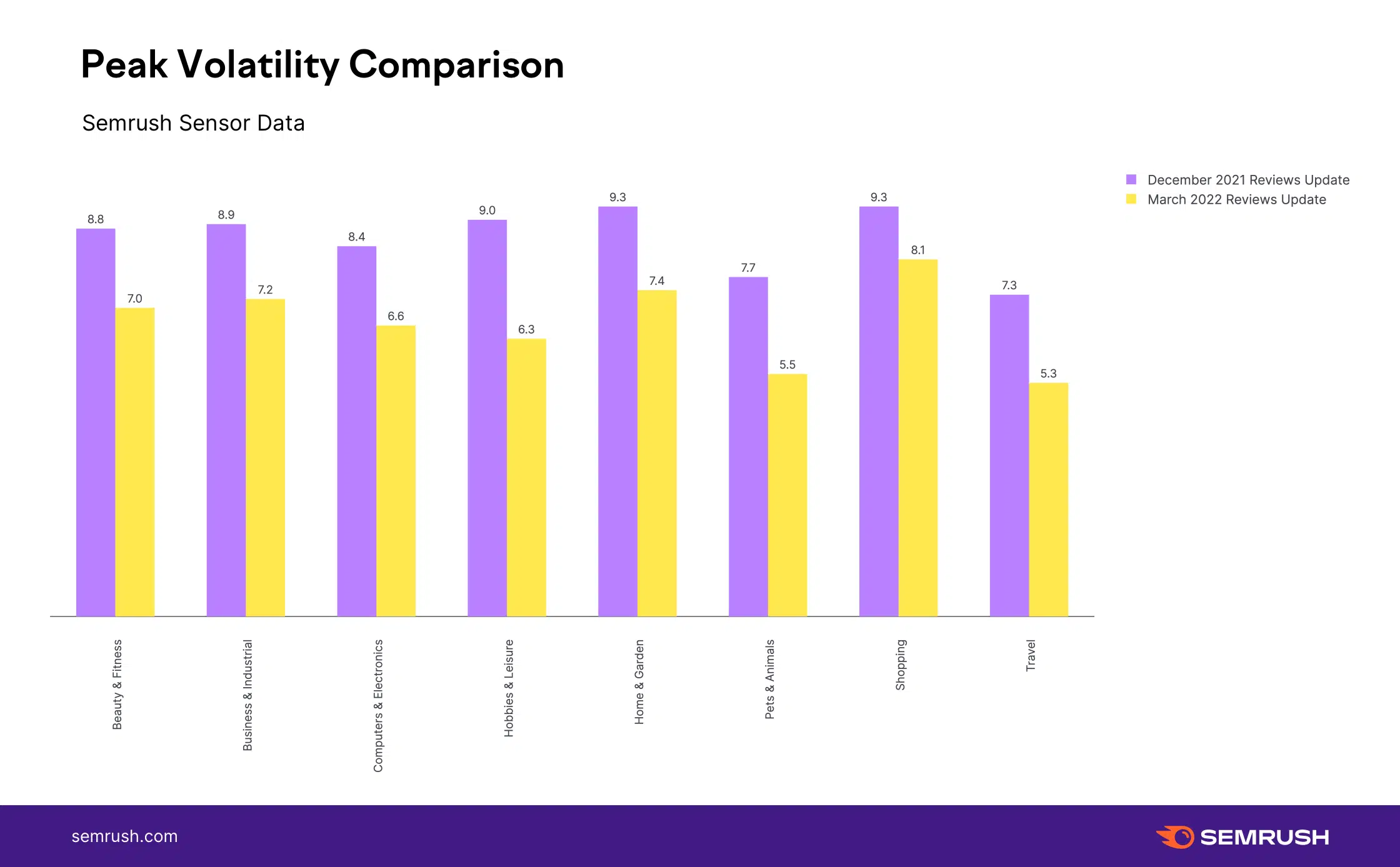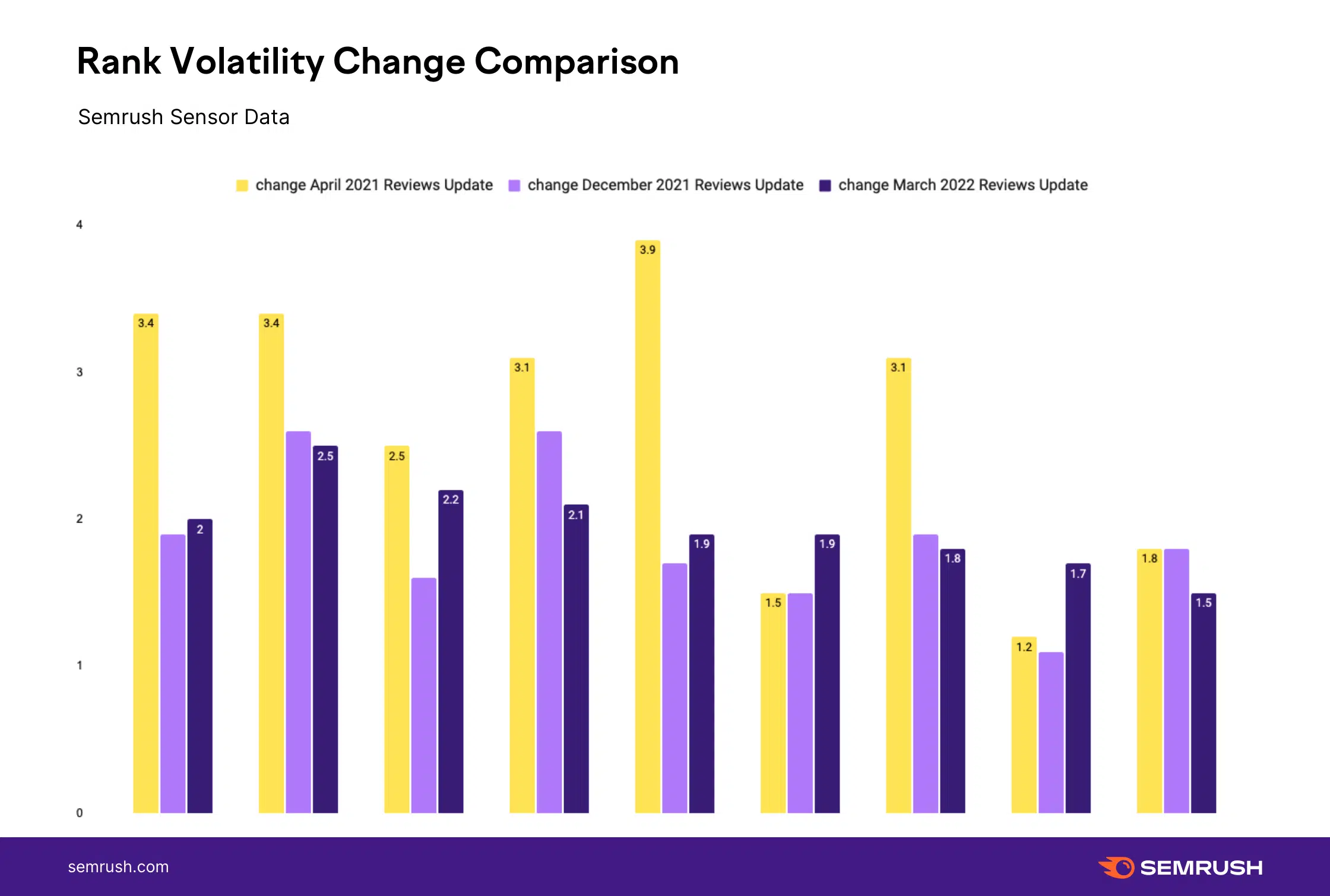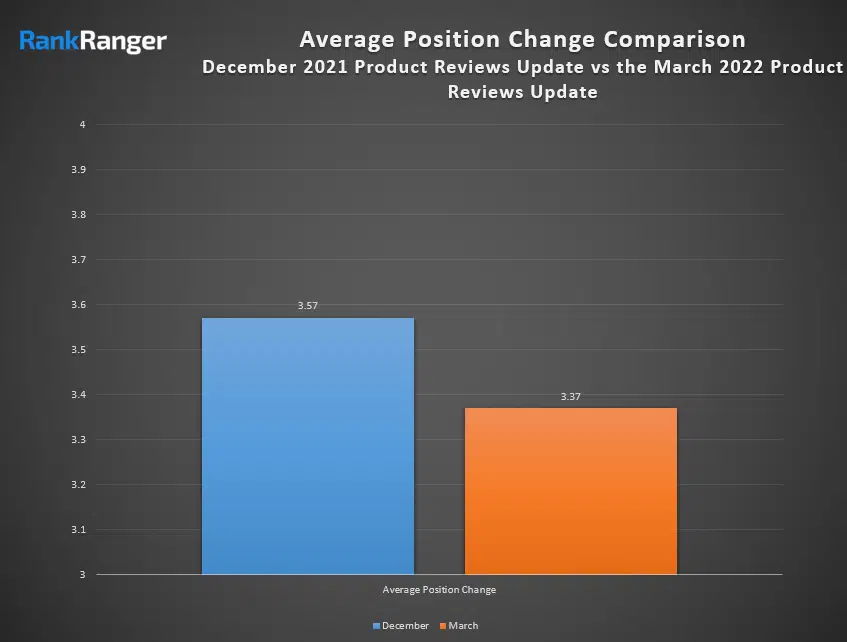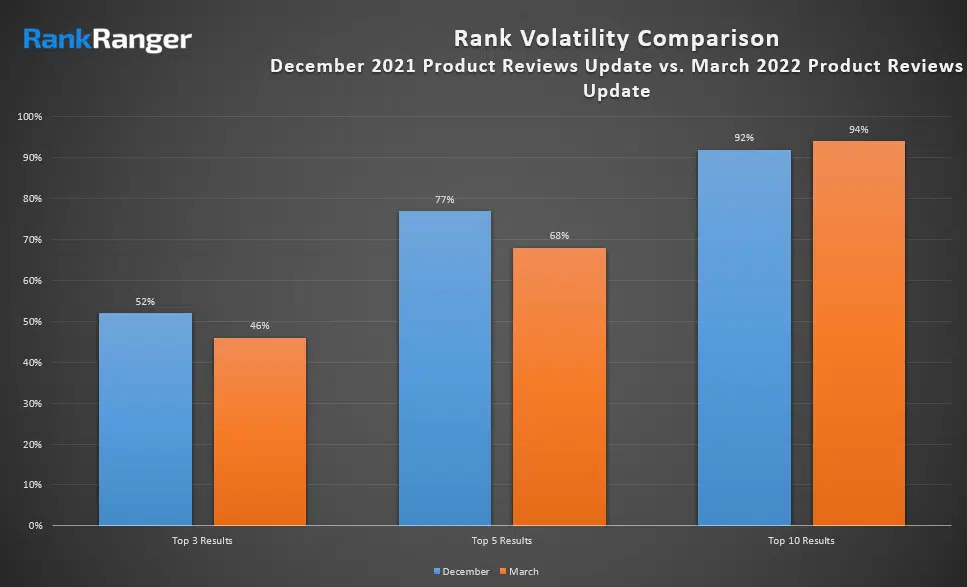Google’s March 2022 product reviews update was smaller than the December 2021 product reviews update, say data providers
As a reminder, the Google product reviews update looks for in-depth analysis, actual product use, unique information and comparable product coverage.
On March 23, 2022, Google begun rolling out the third product reviews update that added additional ranking signals to that ranking algorithm. It seems like the March 2022 product reviews update is just about done rolling out now, so we asked some of the data providers that track the ranking volatility, to tell us what they are seeing. In short, Semrush and RankRanger are showing that the March 2022 product reviews update was less of an impact than the last update, the December 2021 product reviews update that we analyzed over here.
It is also important to note that the March 2022 product reviews update is not officially done rolling out yet, it should be done any day now. We do believe the bulk of the changes should have been felt by now, so we are reporting on the changes we saw today. Google initially said this rollout will happen over the “next few weeks.”
Both providers looked at the highest point of volatility, which was on March 31st and not the March 23rd volatility, as a comparison of this update to others.
Data providers show March was smaller than December
Semrush. Semrush data showed that the March 2022 product reviews update has less Google search ranking volatility than the December 2021 product reviews update. When you compare the December 2021 product reviews update to the March 2022 product reviews update, Semrush said “there’s no comparison in the levels of peak volatility.” “The December 2021 product reviews update saw volatility levels reaching around 9/10 whereas the March product reviews update sees volatility levels between 6-7,” the company added.
Here is a chart comparing the volatility by vertical/niche for March vs December:

But Semrush data went one step further and sent us data on the difference or the change between the volatility levels before a product reviews update and after. You can see in the chart below that the April 2021 product reviews update was directly responsible for increased rank volatility at that time, Semrush explained. In this case you can see the difference between the volatility levels before and after the update is upwards of 3 points for many of the verticals. When you compare this to both the December product reviews update and the March product reviews update, you will see none of the verticals studied showed a difference of more than 2.5 points.
This shows while volatility levels may have been higher overall in December of 2021 – it was not necessarily the product reviews that was the cause, Semrush explained.

In short, the March 2022 product reviews update levels of volatility were “nowhere near what we saw during the December 2021 product reviews update,” Semrush told us. But the caveats mentioned above are important to note.
RankRanger. RankRanger showed similar results, where the March 2022 product reviews update was less impactful than the December 2021 product reviews update. RankRanger said “average fluctuations for the March 2022 update were slightly lower than that of the December 2021 update.” Here is a chart showing that:

If you break it down by position levels, RankRanger showed the fluctuations for the December update were higher in the top three and top five results:

Then they also broke it down by vertical or industry, showing the top three and top five results, volatility were greatest for the retail niche but in the top ten positions, the niches evened out those fluctuations.

Both companies, Semrush and RankRanger looked at March 31st as the peak of this update, here it is illustrated in this RankRanger chart:

RankRanger did also note that the first product reviews update in April 2021 was less impactful than the March 2022 update as you can see from the overall comparison chart below followed by the comparison by ranking position.


So overall, it seems like the March 2022 product reviews update was less of an update compared to the December 2021 product reviews update. Don’t get me wrong, if you were hit by any of these updates, you likely saw a 20 to 40% or more change in Google organic traffic to your site. But how widespread the update was, well, that seemed not as big as previous updates.
More on the March 2022 products reviews update
The SEO community. The March 2022 product reviews update seemed to have a slow start, with some volatility as early as March 23rd but then most of the volatility showed up on March 31st. I was able to cover the community reaction in one blog post on the Search Engine Roundtable. It includes some of the early chatter, ranking charts and social shares from some SEOs. In short, if your site was hit by this update, you probably felt it in a very big way but this was not as widespread as the December update in terms of the chatter within the community.
What to do if you are hit. Google has given advice on what to consider if you are negatively impacted by this product reviews update. We posted that advice in our original story over here. In addition, Google provided two new best practices around this update, one saying to provide more multimedia around your product reviews and the second is to provide links to multiple sellers, not just one. Google posted these two items:
- Provide evidence such as visuals, audio, or other links of your own experience with the product, to support your expertise and reinforce the authenticity of your review.
- Include links to multiple sellers to give the reader the option to purchase from their merchant of choice.
Google added the following criteria for what matters with the March 2022 product reviews update:
- Include helpful in-depth details, like the benefits or drawbacks of a certain item, specifics on how a product performs or how the product differs from previous versions
- Come from people who have actually used the products, and show what the product is physically like or how it’s used
- Include unique information beyond what the manufacturer provides — like visuals, audio or links to other content detailing the reviewer’s experience
- Cover comparable products, or explain what sets a product apart from its competitors
Google added three new points of new advice for this third-release of the products reviews update:
- Are product review updates relevant to ranked lists and comparison reviews? Yes. Product review updates apply to all forms of review content. The best practices we’ve shared also apply. However, due to the shorter nature of ranked lists, you may want to demonstrate expertise and reinforce authenticity in a more concise way. Citing pertinent results and including original images from tests you performed with the product can be good ways to do this.
- Are there any recommendations for reviews recommending “best” products? If you recommend a product as the best overall or the best for a certain purpose, be sure to share with the reader why you consider that product the best. What sets the product apart from others in the market? Why is the product particularly suited for its recommended purpose? Be sure to include supporting first-hand evidence.
- If I create a review that covers multiple products, should I still create reviews for the products individually? It can be effective to write a high quality ranked list of related products in combination with in-depth single-product reviews for each recommended product. If you write both, make sure there is enough useful content in the ranked list for it to stand on its own.
Google product reviews update. The Google product reviews update aims to promote review content that is above and beyond much of the templated information you see on the web. Google said it will promote these types of product reviews in its search results rankings.
Google is not directly punishing lower quality product reviews that have “thin content that simply summarizes a bunch of products.” However, if you provide such content and find your rankings demoted because other content is promoted above yours, it will definitely feel like a penalty. Technically, according to Google, this is not a penalty against your content, Google is just rewarding sites with more insightful review content with rankings above yours.
Technically, this update should only impact product review content and not other types of content.
Why we care. If your website offers product review content, you will want to check your rankings to see if you were impacted. Did your Google organic traffic improve, decline or stay the same? Long term, you are going to want to ensure that going forward, that you put a lot more detail and effort into your product review content so that it is unique and stands out from the competition on the web.
We hope you, your company and your clients did well with this update.
Related stories